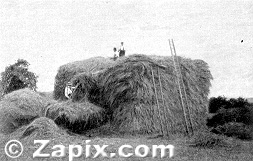|
|
Work and Workers in Rural England,
Page 6 of 13
The busiest seasons on the farm are those of the hay, grain and hop harvests. There is employment then for every one. June is the haymaking month, and its scenes have sometimes as much the air of carnival as of labor. This is especially true when the early fields are mown near the villages. On pleasant evenings half the population is out watching the men swinging their scythes in the slow fading light. The children are in the new-mown grass having a frolic, tumbling about and gathering up great armfuls to throw at each other. Their mothers watch them from over the fence and laugh at their haps and mishaps. The little ones get hot and red-faced, and some are hurt and shed tears, but it is not easy to induce them to start for home before the men stop work at about ten o’clock. Most of the mowing in the level regions of England is done with a machine. Yet there are still many old-fashioned farmers who cling to the idea that a machine leaves about as much as it cuts. Such farmers have the work done by hand even if the farm measures half a thousand acres. The smaller farmers often have no machine, because they do not feel they can afford one, considering the amount they would use it; and on most farms there is a certain amount of land so steep or so much ditched that machine-cutting is not practical.  Haymaking
|
|
|
6
Books & articles appearing here are modified adaptations
from a private collection of vintage books & magazines. Reproduction of these pages is prohibited without written permission. © Laurel O'Donnell, 1996-2006.
|
||


